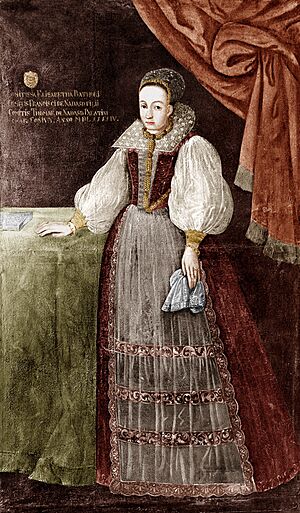Ferenc Nádasdy facts for kids
Quick facts for kids
Ferenc II Nádasdy
|
|
|---|---|
| Baron (later Count) Ferenc Nádasdy | |
 |
|
| Full name |
Ferenc Nádasdy of Nádasd and Fogarasföld
|
| Born | 6 October 1555 Sárvár, Kingdom of Hungary |
| Died | 4 January 1604 (aged 48) Sárvár, Kingdom of Hungary |
| Noble family | Nádasdy |
| Spouse(s) | Elizabeth Báthory |
| Issue | Anna Orsika Katalin András Paul |
| Father | Baron Tamás Nádasdy de Nádasd et Fogarasföld |
| Mother | Orsolya Kanizsay de Kanizsa |
Count Ferenc II Nádasdy (born October 6, 1555 – died January 4, 1604) was an important Hungarian nobleman. His family, the Nádasdy family, was one of the richest and most powerful families in Hungary at that time.
In 1571, when Ferenc was 16, his mother, Orsolya Nádasdy, arranged for him to marry the young Elizabeth Báthory. The Báthory family was also very rich and famous. They were even older and more influential than the Nádasdy family. Some of their relatives were very important people, like a cardinal, a King of Poland-Lithuania, and a Prince of Transylvania.
Contents
Ferenc Nádasdy's Early Life
When Ferenc was 14, he became engaged to Elizabeth Báthory, who was ten years old. He invited her to live at his family's home, Sárvár Castle, in western Hungary.
Ferenc was not as good at reading and writing as his future wife. He could barely read or write in his own language, Hungarian. However, he knew some Latin and German. He wanted to use these languages to help solve problems during the Hungarian wars.
His wife, Elizabeth, was known as one of the most educated women of her time. She could read and write very well. She also spoke Latin, German, and Greek fluently.
Family Life and Čachtice Castle
On May 8, 1575, Ferenc and Elizabeth got married at Varannó Castle. Today, this place is called Vranov nad Topľou in Slovakia. Ferenc was 19, and Elizabeth was 14. Over 4,500 guests came to their wedding!
After they married, Ferenc agreed to use his wife's family name, Báthory. This was because the Báthory name was considered more honorable than Nádasdy at that time. After the wedding, the new Nádasdy lords and other family members moved to Csejte.
Čachtice Castle, located in modern-day Slovakia, was built in the 1200s. The Hont-Pázmány family, a well-known group in Hungary, built it. The castle was on a hilltop, which was a great spot to watch the road connecting Hungary to Moravia (now part of the Czech Republic).
Later, the castle was owned by Matt Csak. He was part of the powerful Stiboríc Stibor family. This shows how power changed hands in the region long ago.
The Nádasdy and Báthory families received Čachtice Castle as part of a wedding gift. The castle and seventeen nearby villages were a huge present. This showed how rich and powerful these families were.
In 1578, Count Ferenc became a leader in the Hungarian army. Because he was often away fighting, he and his wife did not have their first child for 10 years. Their first child, Anna, was born in 1585. She later married Nikola VI Zrinski.
Ferenc and Elizabeth had other children too:
- Orsolya (Orsika) Nádasdy (born around 1590) who married István II Benyó.
- Katalin (Kata or Katherina) Nádasdy (born around 1594).
- András Nádasdy (born around 1596, died 1603).
- Pál (Paul) Nádasdy (born around 1598, died 1650). He was the father of Franz III. Nádasdy.
Ferenc Nádasdy's Military Career
Count Ferenc Nádasdy was a famous soldier in Hungary during the late 1500s. People called him the "Black Bey" because he was so good at fighting.
In the Ottoman–Hungarian Wars, Ferenc helped his country win back many castles from the Ottoman Empire. These castles included Esztergom, Waitzen, Visegrád, Székesfehérvár, and later, Győr. Thanks to Count Nádasdy, the Hungarians gained a big advantage over the Turks. At this time, the central-southern part of Christian Hungary was under Ottoman control.
Ferenc fought alongside his good friend, the Hungarian nobleman Nicholas Pálffy. Pálffy was considered one of the most important military leaders of his time. He had the full support of Rudolf II, who was the Habsburg King of Hungary and Holy Roman Emperor. Pálffy was known for his battles against the Ottoman Turks. He eventually received the title of Earl of Pozsony (now Pressburg, Bratislava).
During his long time in the military, Count Nádasdy was known for his great bravery in battle.
The Death of Ferenc Nádasdy
On January 4, 1604, Ferenc, known as the Black Knight of Hungary, died suddenly during a battle. The exact illness that killed Count Ferenc Nádasdy is still a mystery. However, it is known that he had been suffering from a problem with his legs for at least two years before he passed away.
After Ferenc's Death
After Nádasdy died, his wife, Elizabeth Báthory, inherited his wealth and properties. In July 1614, the Countess left her estate to her children in her will. The process involving Elizabeth ended with her death a month later.
Ferenc and Elizabeth's descendants were later sent away from Hungary and went to Poland. Some of them returned to Hungary after 1640. However, this marked the end of the Báthory-Nádasdy family's special noble status in Hungary.


